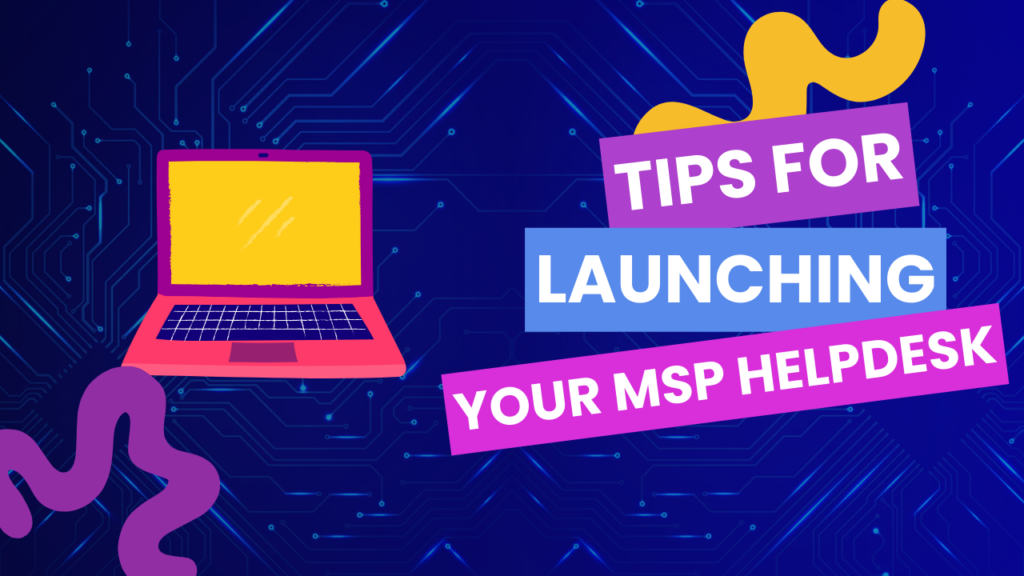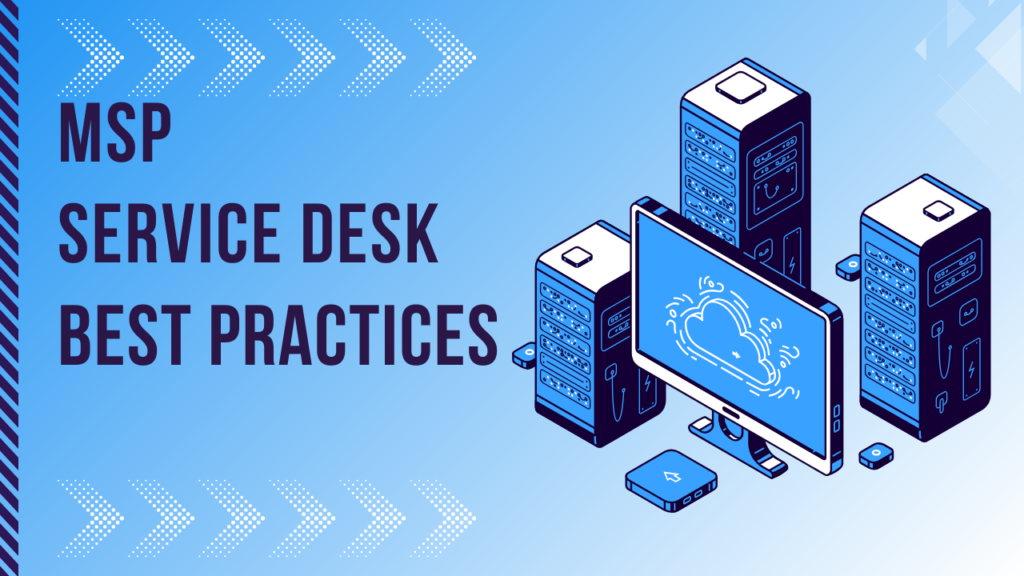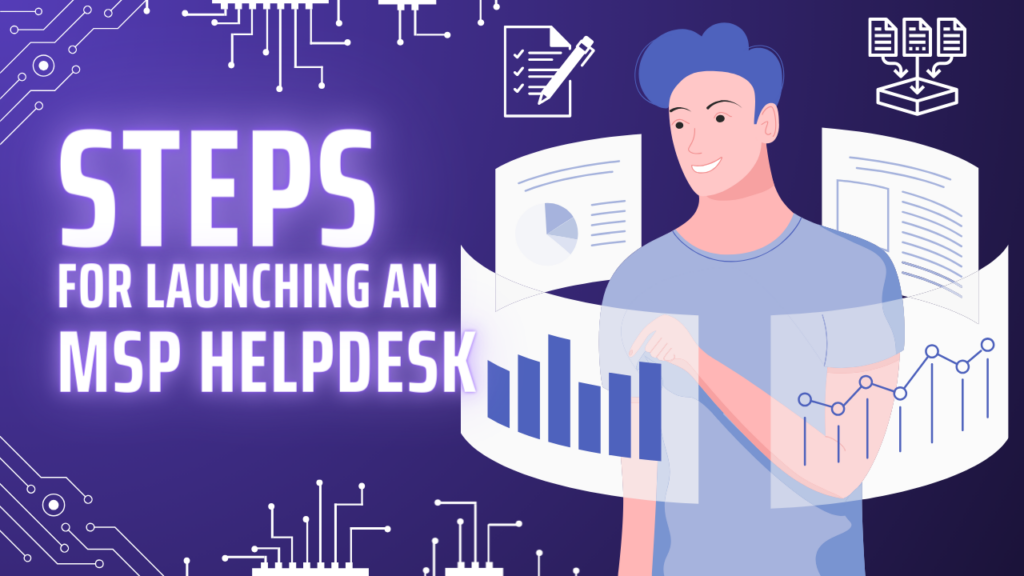Introduction
The importance of a help desk in the MSP business model cannot be overstated. A well-structured MSP help desk is pivotal for maintaining high service quality and ensuring client satisfaction. With the right strategies and tools, MSPs can deliver exceptional managed help desk services that meet their clients’ needs effectively.

Planning and Strategy
Defining the Scope of Help Desk Services
Defining which services and support levels to offer is the first step in establishing a successful MSP help desk. This involves aligning help desk services with overall business objectives. For example, MSPs can decide to provide tiered support levels that cater to different client needs, ensuring comprehensive coverage and efficient resource allocation.
Developing a Business Case
Analyzing the costs versus benefits of a dedicated help desk is crucial. A strong business case should highlight the expected ROI from investing in a managed help desk service. According to SyncroMSP, a well-implemented help desk can significantly reduce downtime and improve client satisfaction, leading to long-term client retention and increased profitability.
Designing the MSP Help Desk Structure
Choosing the Right Model
When designing the service desk structure, MSPs must choose between in-house and outsourced models, or even consider hybrid solutions. In-house service desks offer greater control and integration with existing systems, while outsourced MSP staff can provide flexibility and cost savings. A hybrid model can leverage the best of both worlds, offering robust managed help desk services without compromising on quality.
Staffing Requirements
Determining staffing needs based on the service scope is essential for maintaining efficient operations. Hiring strategies should focus on finding skilled help desk personnel who can handle a variety of technical issues. According to MSP Corp, investing in the right talent ensures that the help desk can deliver high-quality service consistently.
Remote MSP Helpdesk Staff
In today’s globalized and increasingly remote work environment, considering remote MSP helpdesk staff can provide numerous benefits. Outsourced MSP staff can offer flexibility, cost savings, and access to a broader talent pool. This approach allows MSPs to quickly scale their operations and provide around-the-clock support, regardless of geographical boundaries. Additionally, remote staffing solutions can help MSPs manage peak times and unexpected surges in demand, ensuring that client needs are met promptly and efficiently. SuperOps emphasizes the importance of leveraging remote staff to maintain high service standards while optimizing operational costs.
MSP Help Desk: Technology and Tools
Essential Help Desk Software and Tools for your MSP Help Desk
Selecting the right help desk software is crucial for enhancing efficiency and customer experience. MSPs should compare top help desk software solutions, looking for features such as ticketing systems, automation capabilities, and integration with other MSP RMM tools. Reliable sources like ProProfs Desk provide comprehensive comparisons and recommendations for the best help desk tools available.
Integration with Existing MSP Systems
Ensuring compatibility and seamless integration between the help desk software and other MSP systems is vital for smooth operations. Automating workflows between the help desk and other MSP services can streamline processes and reduce manual intervention, leading to faster resolution times and improved client satisfaction.
Process Development
Establishing Effective Procedures
Creating standard operating procedures (SOPs) for common issues is essential for maintaining consistency and efficiency in service desk operations. Developing escalation protocols for complex problems ensures that issues are resolved promptly and effectively. According to HappyFox, clear and well-documented procedures are key to successful service desk management.
The Pitfalls of Ring Groups for MSP Helpdesks
While ring groups, where multiple help desk agents are called simultaneously until someone answers, may seem like an efficient way to handle incoming support requests, they can lead to significant inefficiencies and a poor client experience. Ring groups often result in long wait times and missed calls, as agents may be occupied with other tasks or calls. Additionally, this approach lacks the structured prioritization necessary for effective issue resolution.

For MSPs, implementing a tiered support system with defined roles and responsibilities is a far better practice. This system ensures that each issue is directed to the most appropriate level of support, reducing the time to resolution and improving overall service quality. Escalation protocols can then seamlessly guide more complex problems to higher-level support, maintaining an organized and efficient workflow. By avoiding the pitfalls of ring groups and establishing clear, efficient procedures, MSPs can enhance their managed help desk services, ultimately leading to higher client satisfaction and better operational outcomes.
Quality Assurance
Implementing monitoring and evaluation systems allows MSPs to continuously improve their help desk services. Feedback and performance data should be used to identify areas for improvement and implement changes as needed. Regular quality assurance checks help maintain high service standards and ensure client satisfaction.
Training and Development
Onboarding and Continuous Training
Structuring initial training programs for help desk staff ensures that new hires are well-prepared to handle their responsibilities. Ongoing training and professional development are also crucial for keeping staff updated on the latest tools and techniques. InvGate emphasizes the importance of continuous learning for maintaining a skilled and effective help desk team.
Building a Knowledge Base
A comprehensive and accessible knowledge base is a valuable resource for both help desk staff and clients. It can significantly reduce resolution times and improve the overall efficiency of help desk operations. Maintaining and updating help desk resources ensures that the knowledge base remains relevant and useful.
The Importance of Audits
Regular audits are crucial for ensuring the effectiveness and security of help desk operations. These audits include tracking when passwords were last changed, when software or drivers were last updated, and monitoring other critical system changes. Utilizing software like IT Glue to record and manage these audits can provide a comprehensive overview of the help desk’s activities and compliance with security protocols. IT Glue’s automated audit tools help MSPs ensure that all necessary updates and changes are documented and completed on schedule, reducing the risk of security vulnerabilities and ensuring that systems are running optimally. According to HappyFox, by conducting regular audits, MSPs can maintain high security standards, ensure compliance with best practices, and provide reliable managed help desk services that clients can trust.
Launching Your MSP Help Desk

Pilot Testing your MSP Help Desk
Running a pilot phase before a full-scale launch is crucial for identifying and addressing potential issues. Collecting data and feedback during this phase allows MSPs to refine their help desk services and ensure they meet client expectations. OnPage highlights the importance of thorough testing and adjustments before launching the help desk.
Marketing the Help Desk to Clients
Effective marketing strategies are essential for promoting new help desk services to existing and potential clients. Communicating the value and benefits of the help desk can help attract more clients and increase engagement. Clear and consistent messaging is key to successful marketing efforts.
Leveraging Social Media
Social media platforms are powerful tools for boosting your MSP’s online presence and promoting service desk services. Utilizing platforms like LinkedIn, Facebook, and Twitter allows MSPs to reach a wider audience, engage with clients, and build brand awareness. Regularly sharing updates, success stories, and client testimonials can highlight the effectiveness of your managed service desk services and attract potential clients. More insights can be found in this article on leveraging social media to boost your MSP’s online presence.
Digital Marketing Strategies for your MSP Help Desk
Implementing effective digital marketing strategies is crucial for driving traffic to your help desk services. Utilizing search engine optimization (SEO) to improve your website’s visibility, creating targeted PPC ad campaigns to reach specific audiences, and developing content marketing strategies to provide valuable information to potential clients are all essential strategies. By integrating these strategies, MSPs can enhance their online presence, generate leads, and convert prospects into clients, ultimately supporting the growth and success of their help desk services. Detailed strategies can be found in this article on effective MSP digital marketing strategies.
Measuring Success and Making Adjustments
Key Performance Indicators (KPIs) for MSP Help Desks
Identifying and tracking critical metrics such as response times, resolution rates, and client satisfaction levels is essential for measuring the success of the help desk. Adjusting strategies based on KPI results ensures continuous improvement and optimal performance. The most important KPIs for MSPs include:
- Response Time: The average time taken to respond to a client’s request.
- Resolution Rate: The percentage of issues resolved within a specified time frame.
- Client Satisfaction: Client feedback on the quality and efficiency of support received.
These KPIs help MSPs monitor their help desk performance and identify areas for improvement. For a detailed overview of crucial KPIs for effective MSP business management, refer to this article on key performance indicators for MSPs.
Client Satisfaction Surveys
Utilizing feedback from client satisfaction surveys can provide valuable insights into the effectiveness of help desk services. Implementing best practices in survey methodology and consistently seeking client input helps MSPs make informed adjustments and improve service quality.
Conclusion
Launching a successful MSP help desk requires careful planning, the right tools, and continuous improvement. By defining the scope of services, developing a strong business case, choosing the right help desk structure, and investing in technology and training, MSPs can provide exceptional managed help desk services that enhance client satisfaction and support business growth



0 Comments